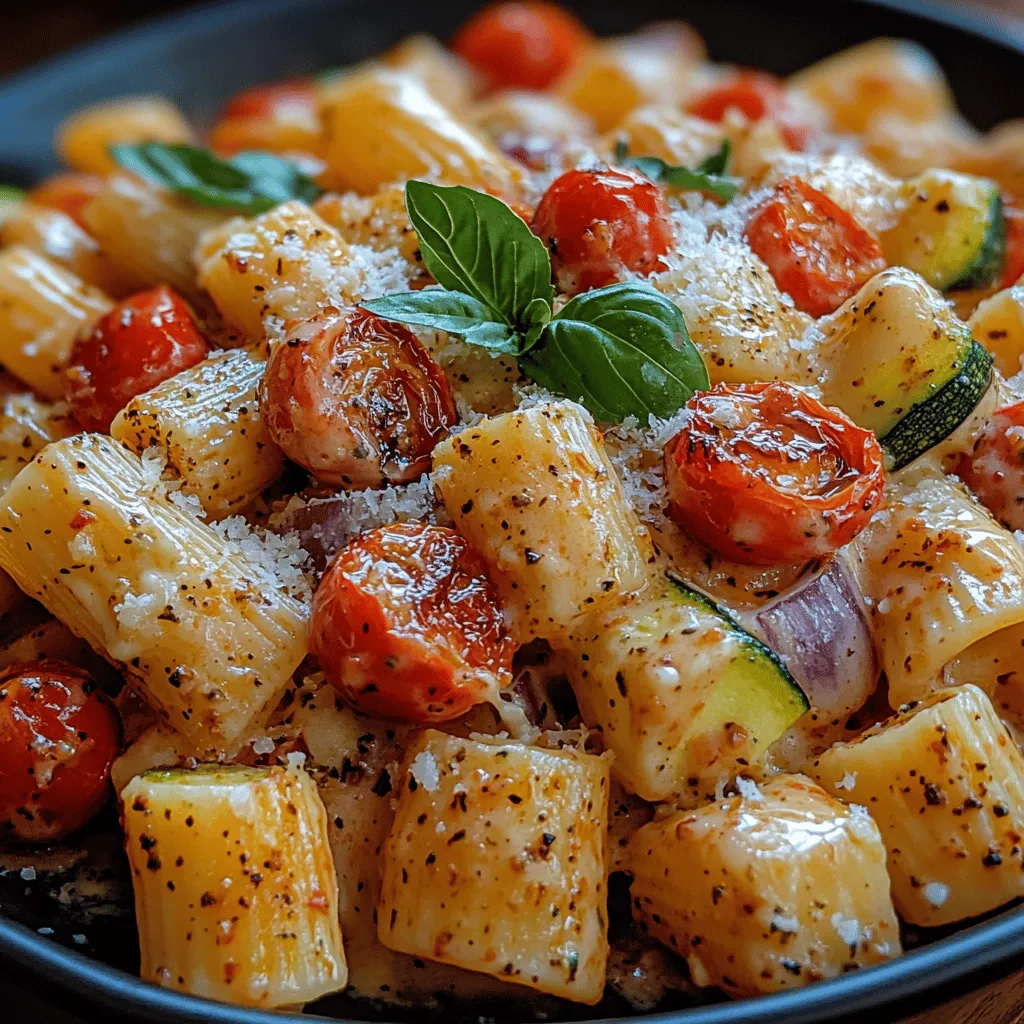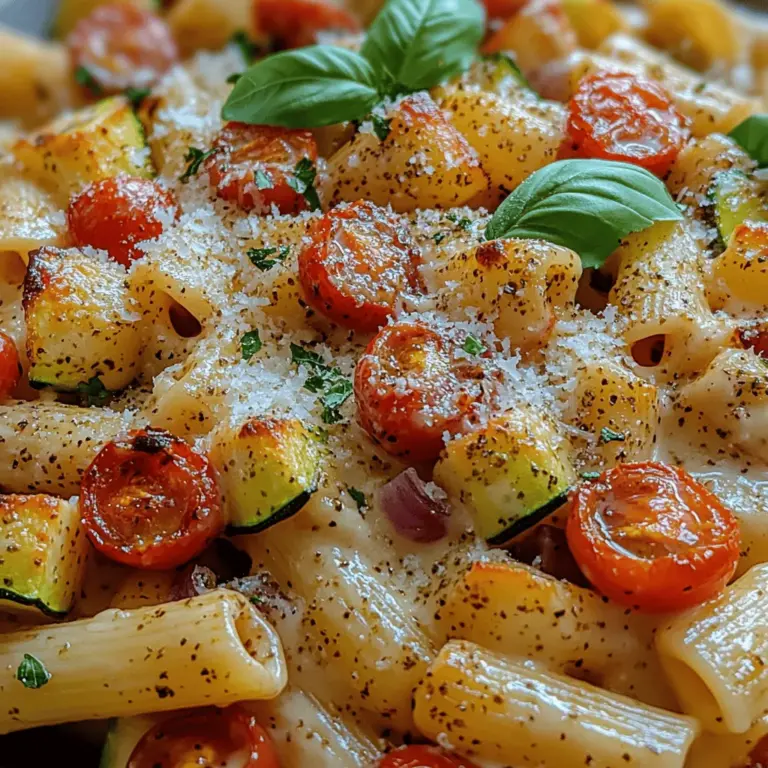Introduction
Creamy pasta dishes have carved a special place in the hearts (and stomachs) of food lovers around the globe. They embody comfort food at its finest, offering a rich, velvety sauce that clings to al dente pasta, creating a dish that is both satisfying and indulgent. Beyond their luscious flavors, creamy pastas offer remarkable versatility, allowing for endless variations to suit personal tastes and dietary preferences.
One of the standout ways to elevate a creamy pasta dish is by incorporating roasted vegetables. Roasting brings out the natural sweetness and enhances the flavors of vegetables, making them a delightful addition to any pasta recipe. Not only does this method add depth to the dish, but it also boosts its nutritional profile, ensuring you enjoy a meal that is both delicious and wholesome. Whether you’re a busy home cook looking for a quick weeknight dinner or a culinary enthusiast preparing for a gathering, creamy roasted veggie pasta is an excellent choice that caters to various dietary needs, including delicious vegan options.
The Allure of Creamy Pasta Dishes
Creamy pasta recipes have gained immense popularity in home cooking, becoming a staple in many households. Their allure lies in the perfect marriage of flavors and textures—smooth, creamy sauces enveloping perfectly cooked pasta create a comforting and indulgent experience. The richness of creamy sauces can transform simple dishes into gourmet meals, making them suitable for any occasion, from cozy family dinners to elegant dinner parties.
The versatility of creamy pasta dishes is another reason for their widespread appeal. You can easily adapt them to include a variety of ingredients, making it simple to accommodate different tastes and dietary restrictions. For instance, you can experiment with different types of pasta, sauces, and vegetables, allowing for a personalized touch that reflects your culinary preferences.
Moreover, creamy pasta dishes often evoke feelings of nostalgia, reminding many of cherished family meals or special gatherings. This emotional connection, combined with the comforting nature of the dish, makes creamy pasta a go-to option for home cooks and food enthusiasts alike.
Nutritional Benefits of Roasted Vegetables
Incorporating roasted vegetables into your creamy pasta not only enhances flavor but also boosts its nutritional benefits. Roasted vegetables are packed with vitamins, minerals, and fiber, making them essential components of a balanced diet. Key ingredients such as cherry tomatoes, zucchini, bell peppers, and red onions each bring unique nutritional advantages to the table.
– Cherry Tomatoes: These bite-sized gems are rich in antioxidants, particularly lycopene, which has been linked to various health benefits, including heart health. They also provide vitamin C and potassium, which are vital for maintaining overall health.
– Zucchini: This versatile vegetable is low in calories yet high in essential nutrients, including vitamin A, vitamin C, and potassium. Zucchini adds moisture and a slight sweetness to dishes, making it a favorite in creamy pasta recipes.
– Bell Peppers: Available in various colors, bell peppers are an excellent source of vitamins A and C, as well as fiber. Their crisp texture and vibrant flavor add a delightful crunch to the creamy pasta.
– Red Onions: These onions offer a milder flavor compared to yellow onions, making them perfect for roasting. They are rich in antioxidants and have anti-inflammatory properties, contributing to overall health.
Roasting vegetables enhances their flavor and texture, caramelizing the natural sugars and creating a satisfying depth of taste. This cooking method transforms any dish, making the vegetables more appealing and enjoyable, especially for those who might not typically favor eating their greens.
Ingredients Breakdown for Creamy Roasted Veggie Pasta
Before diving into the preparation of creamy roasted veggie pasta, it’s essential to gather all the ingredients. Here’s a detailed list of what you’ll need, along with potential substitutions for dietary restrictions:
Ingredients
1. Pasta:
– Type: Any pasta shape you prefer, such as penne, fusilli, or spaghetti. For a gluten-free option, use gluten-free pasta.
– Quantity: Approximately 12 ounces (about 340 grams).
2. Olive Oil:
– Purpose: For roasting the vegetables and adding flavor.
– Substitution: Avocado oil or melted coconut oil can also be used.
3. Cherry Tomatoes:
– Quantity: 2 cups, halved.
– Substitution: Use regular tomatoes, diced, if cherry tomatoes are unavailable.
4. Zucchini:
– Quantity: 1 medium, sliced into half-moons.
– Substitution: Yellow squash can be used as an alternative.
5. Bell Peppers:
– Quantity: 1 red and 1 yellow, sliced into strips.
– Substitution: Any color of bell pepper works, or you can use other vegetables like asparagus or broccoli.
6. Red Onion:
– Quantity: 1 medium, sliced.
– Substitution: Yellow or white onion can be used in place of red onion.
7. Garlic:
– Quantity: 3-4 cloves, minced.
– Substitution: Garlic powder can be used if fresh garlic is not available, but fresh is recommended for the best flavor.
8. Heavy Cream or Dairy-Free Alternative:
– Quantity: 1 cup.
– Substitution: For a vegan option, use coconut cream, cashew cream, or a store-bought dairy-free cream.
9. Parmesan Cheese or Vegan Alternative:
– Quantity: ½ cup, grated.
– Substitution: Nutritional yeast provides a cheesy flavor for a vegan alternative, or you can use a plant-based Parmesan cheese.
10. Salt and Pepper:
– Purpose: For seasoning the vegetables and the sauce.
11. Fresh Basil or Parsley:
– Quantity: A handful, chopped, for garnish.
– Substitution: Any fresh herb of your choice, such as thyme or oregano.
Understanding the role of each ingredient not only enhances the dish’s flavor and texture but also allows you to customize the recipe to fit your dietary needs and preferences.
Step-by-Step Cooking Instructions
Now that you have all your ingredients, let’s walk through the preparation process in a detailed, easy-to-follow format.
Preparation of the Oven and Veggies
1. Preheat the Oven: Start by preheating your oven to 425°F (220°C). A hot oven is crucial for roasting vegetables, as it helps achieve that delicious caramelization and depth of flavor.
2. Prepare the Vegetables: While the oven is heating, wash and chop your vegetables. Halve the cherry tomatoes, slice the zucchini into half-moons, and cut the bell peppers and red onion into strips. Place all the chopped vegetables into a large mixing bowl.
3. Season the Vegetables: Drizzle the vegetables with olive oil and season generously with salt and pepper. Toss them well to ensure that everything is evenly coated. The oil will help the vegetables roast beautifully and ensure they don’t stick to the baking sheet.
Roasting Techniques
4. Arrange on a Baking Sheet: Spread the seasoned vegetables in a single layer on a large baking sheet. This is important; overcrowding the pan can lead to steaming rather than roasting, resulting in tender but less flavorful vegetables.
5. Roast the Vegetables: Place the baking sheet in the preheated oven and roast the vegetables for about 20-25 minutes. Halfway through the cooking time, give them a stir to ensure even roasting. You want them to be tender and slightly caramelized but not mushy.
6. Prepare the Pasta: While the vegetables are roasting, bring a large pot of salted water to a boil. Add your pasta and cook according to the package instructions until al dente. Reserve about a cup of pasta water before draining the pasta, as this starchy water can be useful for adjusting the sauce’s consistency later on.
Following these steps will set the foundation for your creamy roasted veggie pasta, ensuring that the vegetables are flavorful and the pasta is perfectly cooked. In the next section of this article, we will delve into the creation of the creamy sauce that brings this delightful dish together, along with the final assembly of all components for a truly satisfying meal.

Roasting Techniques for Perfect Caramelization
Roasting is not just about cooking vegetables; it’s about transforming their flavors to enhance your dish. To achieve the perfect caramelization and flavor enhancement when preparing the roasted veggies for your creamy pasta, keep a few key techniques in mind:
1. Temperature Matters: Preheat your oven to a high temperature, around 425°F (220°C). This allows the vegetables to roast quickly, promoting caramelization without drying out.
2. Cut Uniformly: Ensure that all vegetables are cut into similar sizes. This promotes even cooking and prevents some pieces from burning while others remain undercooked.
3. Oil It Up: Coat your veggies lightly with olive oil, which not only adds flavor but also aids in the caramelization process. Use just enough to cover them without making them soggy.
4. Don’t Overcrowd: Place your vegetables in a single layer on the baking sheet. Overcrowding can lead to steaming rather than roasting, which inhibits that desirable caramelized exterior.
5. Season Well: Season the vegetables before roasting. Salt, pepper, and herbs can draw out moisture, enhancing flavor and texture. Try using garlic powder, onion powder, or a sprinkle of Italian seasoning for added depth.
6. Monitor the Time: Keep an eye on the roasting process. A good rule of thumb is to roast vegetables for 20-30 minutes, tossing them halfway through to ensure even browning and caramelization.
Cooking the Pasta
While your vegetables are roasting to perfection, it’s time to focus on the pasta. Cooking pasta may seem straightforward, but it’s essential to do it properly to ensure the best results in your creamy roasted veggie pasta.
1. Choose Your Pasta: For this recipe, opt for pasta shapes that hold sauce well, such as penne, fusilli, or farfalle. These shapes capture the creamy sauce and roasted veggies beautifully.
2. Salty Water: Bring a large pot of water to a rolling boil and add a generous amount of salt. The water should taste like the sea. This step is crucial as it enhances the flavor of the pasta as it cooks.
3. Cook Al Dente: Add the pasta and cook it according to the package instructions, usually around 8-12 minutes depending on the type. Aim for al dente, which means the pasta should have a slight bite to it. This texture helps it hold up better when mixed with the creamy sauce.
4. Reserve Pasta Water: Before draining the pasta, reserve about a cup of the starchy cooking water. This water is liquid gold when it comes to adjusting the consistency of your sauce. The starch helps bind the sauce to the pasta, creating a creamy and cohesive dish.
5. Drain and Rinse: After cooking, drain the pasta in a colander but do not rinse it. Rinsing washes away the starch and can prevent the sauce from adhering properly.
Combining Ingredients
Now that both the roasted veggies and pasta are ready, it’s time to combine them into a harmonious dish. Follow these steps to ensure that every bite is flavorful and satisfying:
1. Mix Veggies and Pasta: In a large mixing bowl or directly in the pot used for the pasta, combine the drained pasta and the roasted veggies.
2. Add Cream: Pour in your chosen cream (heavy cream, half-and-half, or a dairy-free alternative). Start with a small amount and adjust based on your preference for creaminess.
3. Adjust Consistency: Use the reserved pasta water to adjust the sauce’s consistency. Add a little at a time until you reach your desired creaminess. This water not only thins the sauce but also helps it cling to the pasta.
4. Seasoning: Taste the mixture and season with additional salt and pepper as needed. Remember that flavors intensify as they meld, so be cautious not to over-season at this stage.
5. Toss Gently: Use tongs or a large spoon to gently mix all ingredients together, ensuring the pasta is evenly coated in the creamy sauce and combined with the vegetables.
Flavor Enhancements and Variations
One of the best aspects of creamy roasted veggie pasta is its versatility. Feel free to customize the recipe based on your preferences or what you have on hand:
1. Vegetable Variations: While this recipe may focus on traditional vegetables like bell peppers, zucchini, and broccoli, feel free to experiment. Try adding asparagus, carrots, or even roasted mushrooms for a different texture and flavor profile.
2. Herbs and Spices: Fresh herbs like basil, parsley, or thyme can elevate the dish’s freshness. Alternatively, adding a pinch of red pepper flakes can introduce a delightful heat. Garlic and onion powder can also amplify the flavor if you desire a stronger taste.
3. Cheese: Incorporating grated cheese such as Parmesan or Pecorino Romano can add a rich, salty flavor. For a creamier texture, consider stirring in some cream cheese or mascarpone just before serving.
4. Sauce Variations: To switch things up, consider using a pesto sauce instead of cream for a different flavor profile. A lemon cream sauce can also brighten the dish, adding a refreshing twist.
Serving Suggestions and Pairings
Presentation can elevate your creamy roasted veggie pasta from a simple dish to an elegant meal. Here are some serving suggestions to consider:
1. Plating: Serve the pasta in shallow bowls to showcase the colorful veggies. Top with freshly grated cheese and a sprinkle of herbs for a touch of sophistication.
2. Garnishes: A drizzle of good-quality olive oil or a squeeze of fresh lemon juice just before serving can enhance flavors. A sprinkle of crushed red pepper adds a pop of color and flavor.
3. Complementary Dishes: Pair this pasta with garlic bread or a fresh garden salad for a well-rounded meal. For a heartier option, consider serving it alongside grilled chicken or shrimp.
4. Beverage Pairings: A light white wine, such as Sauvignon Blanc or Pinot Grigio, pairs beautifully with the creamy flavors of the pasta. If you prefer non-alcoholic options, a sparkling water with lemon can be refreshing.
5. Occasion Adaptability: This dish is perfect for family dinners but also suitable for entertaining. Consider serving it in a communal dish for casual gatherings or in individual portions for a more formal setting.
Storage and Reheating Tips
If you have leftovers (though they might be hard to resist), proper storage is crucial to maintain the dish’s freshness:
1. Storage: Allow leftovers to cool completely before transferring them to an airtight container. Store in the refrigerator for up to 3-4 days. For longer storage, consider freezing the pasta, but be aware that the texture of the cream may change upon thawing.
2. Reheating: When reheating, use a skillet over low heat, adding a splash of reserved pasta water or cream to maintain creaminess. Stir frequently to avoid sticking and ensure even heating.
3. Freshness Duration: Consumed within the recommended timeframe, your creamy roasted veggie pasta will remain safe and delicious. Avoid letting it sit out at room temperature for more than two hours to prevent spoilage.
Conclusion
Creamy roasted veggie pasta is not just a meal; it’s a delightful blend of flavors, textures, and colors that brings warmth to any table. With its customizable nature, you can easily adapt it to fit your tastes or dietary needs, making it a perfect choice for any occasion.
Whether you are preparing a comforting weeknight dinner or impressing guests at a dinner party, this dish will not disappoint. The joy of cooking and sharing food with loved ones is truly special, and this recipe embodies that spirit perfectly.
So gather your ingredients, unleash your creativity, and enjoy the process of making this comforting, nutritious meal. You will not only satisfy your taste buds but also create lasting memories around the dinner table.

